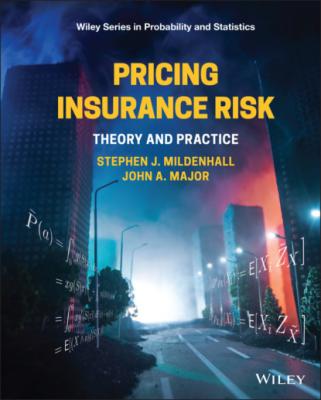Pricing Insurance Risk. Stephen J. Mildenhall
Чтение книги онлайн.
Читать онлайн книгу Pricing Insurance Risk - Stephen J. Mildenhall страница 30
 corner). We might say these units are potentially consumed by event j = 9. The eight units 91–98 are at risk from events j = 8 and j = 9. The step heights of the shaded area correspond to ΔX in the table and ΔX7 for row j = 7 is shown. At the bottom of the graph, the first unit of assets is needed to fund events j = 2 through 9. Event j = 1 has a zero loss, which does not require any assets. The plots in Figure 3.11 show the same function (different data values) rotated by 90 degrees to make the interpretation as ∫S(x)dx clearer.
corner). We might say these units are potentially consumed by event j = 9. The eight units 91–98 are at risk from events j = 8 and j = 9. The step heights of the shaded area correspond to ΔX in the table and ΔX7 for row j = 7 is shown. At the bottom of the graph, the first unit of assets is needed to fund events j = 2 through 9. Event j = 1 has a zero loss, which does not require any assets. The plots in Figure 3.11 show the same function (different data values) rotated by 90 degrees to make the interpretation as ∫S(x)dx clearer.
Figure 3.13 Lee diagram showing relationship between differen asset layers and the events they fund.
Given the increasing sequence Xj, it is convenient to define j(a)=max{j:Xj<a} and j(0)=0. It is the index of the largest observation strictly less than a. For example, j(90)=6 and j(91)=7. It is used in calculations as follows. To compute the limited expected value of X at a > 0, the survival function form evaluates
because ΔXj is the forward difference. It computes the integral as a sum of horizontal slices, e.g. the ΔX7 block in Figure 3.13. For a = 0 obviously E[X∧0]=0. For a=∞, j is set to j + 1, where j is the maximum index with S(Xj)>0, resulting in the unlimited E[X].
The outcome-probability form is
It computes the integral as a sum of vertical slices, e.g. the ΔS5 block in Figure 3.13.
When a = 80, Table 3.4 shows the above calculations through the simple expedient of replacing X values with X∧a and recomputing other columns that depend on X. Notice that columns involving S still use X’s survival function. Numbers changed from Table 3.2 are displayed in bold.
Table 3.4 Computing the limited expected value of X, limited to a = 80. X’ refers to X∧ a but values related to S are unchanged
| j | X' | ΔX' | ΔS | S | X'ΔS | SΔX' |
|---|---|---|---|---|---|---|
| 0 | 0 | 1 | 0.25 | 0.75 | 0 | 0.75 |
| 1 | 1 | 7 | 0.125 | 0.625 | 0.125 | 4.375 |
| 2 | 8 | 1 | 0.125 | 0.5 | 1 | 0.5 |
| 3 | 9 | 1 | 0.0625 | 0.4375 | 0.563 | 0.438 |
| 4 | 10 | 1 | 0.125 | 0.3125 | 1.25 | 0.313 |
| 5 | 11 | 69 | 0.0625 | 0.25 | 0.688 | 17.25 |
| 6 | 80 | 0 | 0.125 | 0.125 | 10 | 0 |
| 7 | 80 | 0 | 0.0625 | 0.0625 | 5 | 0 |
| 8 | 80 | 0 | 0.0625 | 0 | 5 | 0 |
| Sum | 1 | 23.625 | 23.625 |
3.6 Risk Measures
An ice cream manufacturer wants to introduce a product that customers will prefer over existing ones. It would be very helpful to have a way of predicting customer ice cream preferences. As far as a customer is concerned their preference may be very simple and intuitive: “this brand tastes better!” That preference is not expressed in a way that the manufacturer can use to predict customer responses to a new product. However, through taste tests